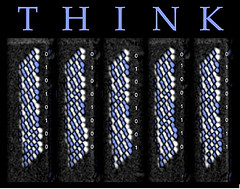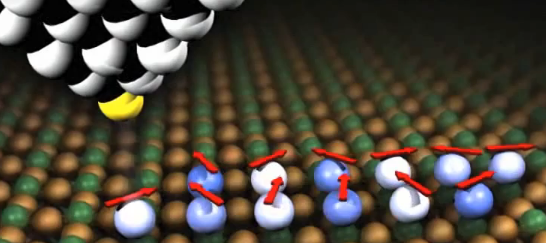 IBM Research scientists have successfully demonstrated the ability to store one bit of information in as few as 12 magnetic atoms. Now that is truly impressive, because today’s disk drives use about one million atoms to store a single bit of information – so yes, there is indeed a considerable degree of scope to leverage a far higher degree of information persistence.
IBM Research scientists have successfully demonstrated the ability to store one bit of information in as few as 12 magnetic atoms. Now that is truly impressive, because today’s disk drives use about one million atoms to store a single bit of information – so yes, there is indeed a considerable degree of scope to leverage a far higher degree of information persistence.
The ability to manipulate matter by its most basic components — atom by atom — could lead to the vital understanding necessary to build smaller, faster and more energy-efficient devices.
While silicon transistor technology has become cheaper, denser, and more efficient, fundamental physical limitations suggest this path of conventional scaling is unsustainable. Alternative approaches are needed to continue the rapid pace of computing innovation.
IBM scientists have taken a novel approach, they started with the smallest unit of data storage, the atom, and have successfully demonstrated magnetic storage that is many times denser than today’s hard disk drives and solid state memory chips. It illustrates that future applications of nanostructures built one atom at a time, using an unconventional form of magnetism called antiferromagnetism, could allow users to store a lot more information.
“The chip industry will continue its pursuit of incremental scaling in semiconductor technology but, as components continue to shrink, the march continues to the inevitable end point: the atom,” said Andreas Heinrich, the lead investigator into atomic storage at IBM Research-Almaden, “We’re taking the opposite approach and starting with the smallest unit — single atoms — to build computing devices one atom at a time.”
How does it Work?
Ferromagnets use a magnetic interaction between its constituent atoms that align all their spins — the origin of the atoms’ magnetism — in a single direction. A major obstacle for miniaturizing ferromagnets down to atomic dimensions is the interaction of neighboring bits with each other.
 Current flowing in STM tip switches bit from 0 to 1 or 1 to 0 by changing magnetic spin polarities of atoms (1 bit requires 12 atoms) at nanosecond speed (credit: IBM Research)
Current flowing in STM tip switches bit from 0 to 1 or 1 to 0 by changing magnetic spin polarities of atoms (1 bit requires 12 atoms) at nanosecond speed (credit: IBM Research)
 A byte (letter or number) is represented by 8 bits (credit: IBM Research), so that is just 96 atoms.
A byte (letter or number) is represented by 8 bits (credit: IBM Research), so that is just 96 atoms.
IBM Research scientists used antiferromagnets (which are not affected by neighboring magnetic fields) and a scanning tunneling microscope (STM) to atomically engineer a grouping of twelve antiferromagnetically coupled atoms that stored a bit of data for hours at low temperatures. Taking advantage of their inherent alternating magnetic spin directions, they demonstrated the ability to pack adjacent magnetic bits much closer together than was previously possible. This greatly increased the magnetic storage density without disrupting the state of neighboring bits.
More info can be found at this link: www.ibm.com/atomicscalememory
Ref.: Sebastian Loth et al., Bistability in Atomic-Scale Antiferromagnets, Science, 335 196 (2012); DOI: 10.1126/science.1214131